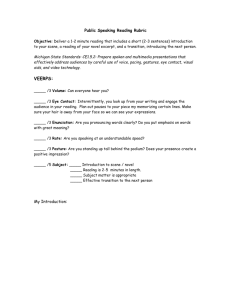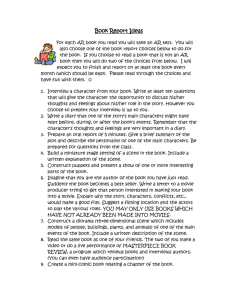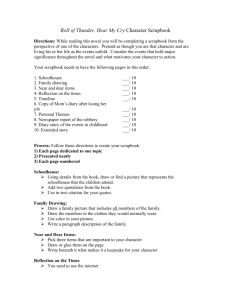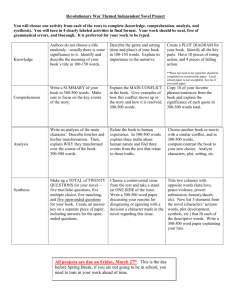Book Report Project Options
advertisement
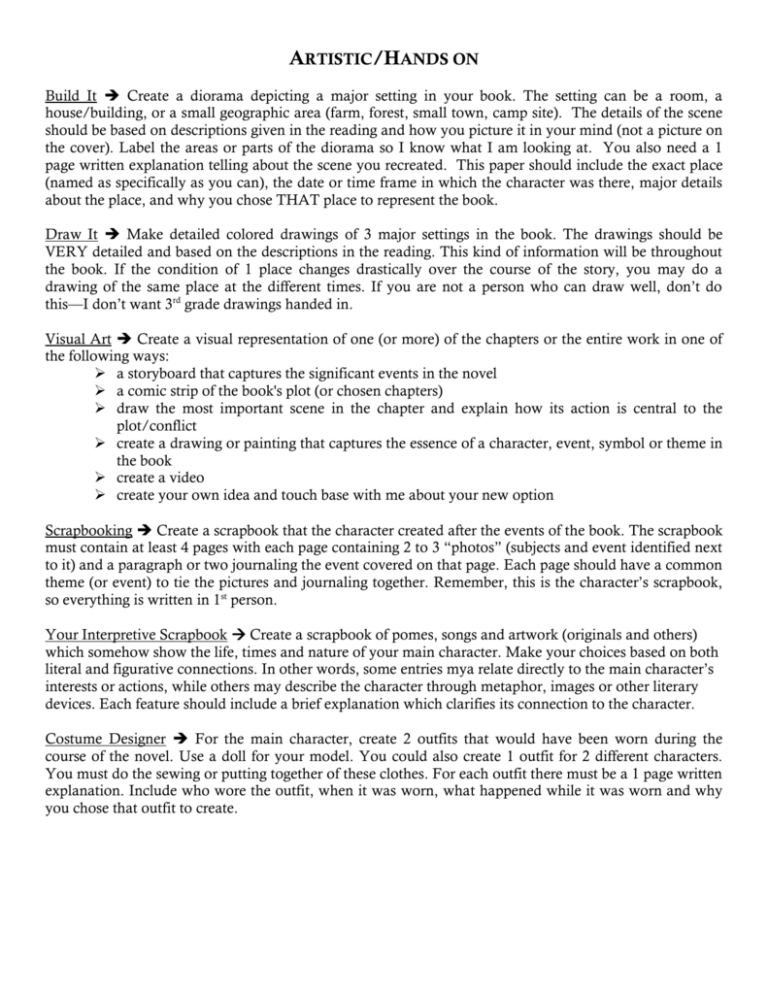
ARTISTIC/HANDS ON Build It Create a diorama depicting a major setting in your book. The setting can be a room, a house/building, or a small geographic area (farm, forest, small town, camp site). The details of the scene should be based on descriptions given in the reading and how you picture it in your mind (not a picture on the cover). Label the areas or parts of the diorama so I know what I am looking at. You also need a 1 page written explanation telling about the scene you recreated. This paper should include the exact place (named as specifically as you can), the date or time frame in which the character was there, major details about the place, and why you chose THAT place to represent the book. Draw It Make detailed colored drawings of 3 major settings in the book. The drawings should be VERY detailed and based on the descriptions in the reading. This kind of information will be throughout the book. If the condition of 1 place changes drastically over the course of the story, you may do a drawing of the same place at the different times. If you are not a person who can draw well, don’t do this—I don’t want 3rd grade drawings handed in. Visual Art Create a visual representation of one (or more) of the chapters or the entire work in one of the following ways: a storyboard that captures the significant events in the novel a comic strip of the book's plot (or chosen chapters) draw the most important scene in the chapter and explain how its action is central to the plot/conflict create a drawing or painting that captures the essence of a character, event, symbol or theme in the book create a video create your own idea and touch base with me about your new option Scrapbooking Create a scrapbook that the character created after the events of the book. The scrapbook must contain at least 4 pages with each page containing 2 to 3 “photos” (subjects and event identified next to it) and a paragraph or two journaling the event covered on that page. Each page should have a common theme (or event) to tie the pictures and journaling together. Remember, this is the character’s scrapbook, so everything is written in 1st person. Your Interpretive Scrapbook Create a scrapbook of pomes, songs and artwork (originals and others) which somehow show the life, times and nature of your main character. Make your choices based on both literal and figurative connections. In other words, some entries mya relate directly to the main character’s interests or actions, while others may describe the character through metaphor, images or other literary devices. Each feature should include a brief explanation which clarifies its connection to the character. Costume Designer For the main character, create 2 outfits that would have been worn during the course of the novel. Use a doll for your model. You could also create 1 outfit for 2 different characters. You must do the sewing or putting together of these clothes. For each outfit there must be a 1 page written explanation. Include who wore the outfit, when it was worn, what happened while it was worn and why you chose that outfit to create. CREATIVE WRITING Dear Diary Create a diary or journal written by the main character (1st person). Include 6 entries written in the handwriting and style of the main character. Include a date for each entry (use the book). Include not only what is happening to you (M.C.), but also how you feel about it and what you want to do about it. If something bad happens to you, don’t just casually put it in your diary, write it as you would if this were happening to you. Use details from the book and feelings you think the character would have. Decorate the diary to look like it belongs to the character. Internal Monologue This is like talking to yourself and will resemble the “Dear Diary” option. If your main character is not somewhere that he/she could be keeping a diary or journal, they would still be thinking about the things that are happening to him or her. This project records the thoughts of the main character. You will write what the character thinks and feels about what is going around him/her. You may do a character other than the main character (maybe the “bad guy”) and look at the situation from a different point of view. Each monologue should be a page long and there should be 6 of them. Letters Between Friends Write a series of letters that would be sent between 2 different characters in the book. Make clear your understanding of the novel through what is said in these letters. Base your writing on what each character would say and do. Write as each character would write—use the phrasing THEY would use (not you). Choose the paper that each character would use for writing letters. EX. A girl (use stationary) writing to a boy (use notebook paper). Put dates on each letter. You can even go as far as to put them in envelopes with addresses and stamps and post marks. Extra! Extra! Create the front page of a newspaper by writing 3 or 4 articles that tell about different events that happen in the book. Come up with a name for your paper and make a masthead (that the top part with the name of the paper and date). Each article should have a headline (title), byline (who wrote it) and at least 4 paragraphs (remembering that newspapers have shorter paragraphs). When writing the articles for your paper, try to imitate journalistic style as you tell who was involved, what happened, where and when it happened and if possible how and why it happened. Include quotes from characters that could have been interviewed. Photographs and the cut line (caption under it) are not considered articles. The paper could be a city paper or school paper depending on where your story is taking place. Gender-Bender Imagine how the book would change is the main character(s) were the opposite gender. Rewrite one part of the book changing the gender of the characters to show how they might act differently (e.g. Lord of the Flies). [1½ to 2 pages] the climax an important conversation between 2 or more characters the consecutive and significant events in the rising action You are a Character Through the magic of imagination, you are able to become a character in the book. Rewrite a scene or chapter of the book including a new character—YOU—in the action. Pretend you have been a part of the book from the beginning—we are just seeing this particular scene. Add dialogue that would fit in with the book. Imitate the author’s style of writing in creating this 2 page story. Fictional Character Biography Write a biography of one of the characters who most interests you. You can take the liberty to begin the biography before the book starts and continue after it ends. [2 pages] Fictional Character Autobiography Have the character that most interests you write his/her autobiography of the time before, during and/or after the story occurs. [2 pages] Finish the Book Sometimes a book just ends and you, the reader, are left to figure out what happened. If you like to write stories, now is your chance. Imitating the style of the author and writing from the same point of view as the book, write one more chapter for the book: the FINAL chapter that the author didn’t give. Tie up the loose ends that the author left to your imagination. What is the next thing that happens to the main character? Set the scene and tell what you imagined happened next. Do not just give a summary. [1½ to 2 pages] The Lost Scene In movies, many scenes end up “on the cutting room floor” as they say. That means they just didn’t fit or there wasn’t enough time to keep them in. Write a scene that could fit into your book. Follow the author’s style, include dialogue, and make it fit into the plot. Before you begin your scene, give me an introduction that tells where this scene is coming in the book. Tell what is happening before and what happens after this scene. [1½ to 2 pages] Rosencrantz and Gildenstern Write a story or journal from the perspective of characters with no real role in the story (very minor characters) and show us what they see and think from their perspective . You will be retelling the story from the book from the point of view of this character. The events of the novel you read will become the minor things happening in your story or journal. (For example, the neighbor in “The Tell-Tale Heart” would write about the crazy man that is living in the house with his old neighbor, and then would tell about the scream he heard one night and going to the police, and then finding out about the murder). You Be the Doctor Pretend you are a psychologist and the subject of your book is your patient. He or she has come to you for help in going on with life after the war. Create a file (you can use an actual file folder) of tests and patient responses. These will include information about what he/she experienced before, during, and after the war. “Run” 3 tests or methods for you patient. Record the patient responses and your observations and/or diagnoses. Here are some methods you can use: Hypnosis (this would be tricky considering what survivor have experienced)—Record what you ask them to relive and what their response is to experiencing this again. Word Association (You say a word and they say what that word brings to mind.) EX. You say “Cat”//Response “I had a kitten named Morte and one day he disappeared. Later I found out my dad gave him to some non Jewish friends in the country so he wouldn’t have to turn him over to the Nazis to be killed.” Rorschach Test (Ink blots—find 2 samples on the internet or make your own using paint) You include the ink blots and write what the patient sees in the ink blot and what you feel this says about him/her. Drawing Therapy (Patient draws a picture of a family or home or something else) Include their picture—actually drawn by you—and what you feel it tells you about the patient. Dream Interpretation (Patient keeps a journal of dreams for 1 month) Include the journal and your thought on what these dreams mean. For example, do they have the same dream over and over? What does that mean? Thematic Apperception Test (Show pictures of different scenes and have the patient make up a story about the scene). Include the pictures shown and the story the patient tells. Include your analysis about the story’s meaning to the patient. BASIC PROJECTS Media Connections Search newspapers, magazines, and the internet to find real life articles that somehow relate to the issues and ideas in the book you read. Cut or print out the articles and paste them on plain paper. Around the edges of the article write your “connections” to the book. Find 3 articles. The Perfect Gift You are responsible for choosing a different and appropriate gift for four of the characters from the novel. Create a visual of each gift, name the character who will receive it, and write an explanation of why the gift is perfect for that character. The gifts can be concrete (a thing) or abstract (an idea such as peace, or romance). The Sequel Write a plan for the plot of the sequel to this book (obviously, there shouldn’t already be one). To make it easy, the sequel will have the same number of chapters as this book. Then, tell what would happen in each chapter of the sequel. Two or three sentences will be enough to tell what would happen since you are just giving a brief look at the plot. Moviemaker Write a one page “pitch” to a producer explaining why the story would or would not make a great movie. If the pitch is to make the movie, what scenes could be cut (and why) to bring the novel to a manageable time limit? Who would you cast in the main roles and where would it be set? Interview with a Character Pretend you are a reporter. Write 10 questions you would ask the main character. Do not include “yes” or “no” questions—only the type Oprah or Barbara Walters or Katie Couric would ask. You are trying to get to the in-depth stuff. For each question, write the character’s response you think he/she would give. Provide details from events in the book as well as thoughts or feelings about these events. Show the character’s personality through the answers. Time Line Create a detailed timeline containing at LEAST 10 events that happened to the main character throughout the novel. Organize the events in chronological order. If dates are provided—give them. For each event, make a title and then beneath that, briefly (2 sentences at least) tell what happened and where it happened. Historical Timeline If you have read a historical fiction book or a book that has dates included, create a 2-sided timeline. On the top of the timeline, write a brief explanation of 8 events that happen in the story. Give a title for each event. On the bottom of the timeline, write the events that were happening in history (include the dates). For example, a book about World War II, write what was happening to your character and what was happening in the war. You will need to use other sources to find the historical information. Be sure that all the events are in chronological order. High Tech It Prepare a Power Point presentation that contains at least 8 slides. Add clip art and special effects to make it interesting. Save your slideshow on a CD. The presentation must include: The title and author of the book The main character and a brief description Important minor characters The conflict of the main character Illustrations or descriptions of 3 major events leading to the climax The climax of the book An explanation of how the conflict was solved Your personal reactions to the book A rating or recommendation of the book Map It Create a map highlighting places described in the story. The map’s features should be based on information provided by the book’s author. The map might show the immediate neighborhood or community in which the book takes place. You may have to put information together to draw conclusions about where places/things are located. The map can be in the form of a floor plan for a house/building if that is the main setting. On the map, label each place. On a key to the map, you will explain what happened here—this is your defense for putting that place on the map. You Be the Teacher Write a test that would come at the end of the reading of this novel. Your test should have 3 parts: Vocabulary (choose 10 words you found difficult), Comprehension (short answer and multiple choice questions that question the basic understanding of the characters and plot), Essay (give essay questions that would look for the students understanding of the meaning of the novel). Your test should have at least 25 questions total. Include a key to your test. Also, come up with a project that would go along with the novel. Create an explanation sheet that would be given to the students upon the introduction of the project. Speculation/Realization Before you get to the end of the book (3 to 6 chapters before the end) based on what you know now in the story, what do you think will happen at the end and why do you think that? Once you have finished the book, reread your speculation and write about what really happened and how you feel about the author ending the book that way. [2 pages] Dear Main Character Write a letter to the main character of your book. Tell this character what you think of him or her. Do you agree with decisions made or actions taken in the book? You may ask about what he or she was thinking at the time a certain thing was done. Your letter should not be “pen pally” (you know, just asking a bunch of questions). Dig into the plot of the book and the motivations of this character. Write at least 1½ pages. Dear Author Write a letter to the author giving your reaction to the book using the friendly letter format. Topics you might discuss would be your reaction to the storyline as a whole, your reaction to the main character(s), what you liked or didn’t like about the plot or characters and why you would or wouldn’t recommend this book to a friend. Write at least 1½ pages. ESSAYS Compare/Contrast Two Characters Choose another character in the book to compare or contrast with the main character. This should be at least a 5-paragraph essay. Look at the personalities of the characters, the reactions to the same events, what motivates each character, how each responds to the people around him/her. These are just some ideas of areas to compare or contrast. Do not make this a physical comparison. Second Chance Write about how the story would change if a certain character had made a different decision earlier in the story. (e.g. what if Huck had not run away?) This should be 1½ to 2 pages. In Twenty Years Take a trip into the future of your main character. See what he/she is doing 20 years after the events of the book. Where does he/she live? What is he/she doing for a living? Any family? Any friends? Does he/she still keep in touch with anyone from the time of the book? Include the character’s reflection about the event(s) that took place 20 years ago. How does he/she feel about what happened back then? Are there any regrets or feats that still linger? In looking back, is this a proud time for him/her? Trading Places In a 2-page essay, answer this question: Would you want to trade places with a character in the book? Your introductory paragraph should state the character, would you or would you not trade places, and a brief overview of your reasons. Your next paragraph should give a quick rundown on what the character experienced in this novel. The next paragraphs will provide solid reasons and support for your answer. Inspirations Watch a film inspired by a story (e.g. Franny and Alexander is inspired by Hamlet) or based on your novel and compare/contrast the works in two pages. You can also use a movie that was done from a book (they both have the same title). You cannot use a book that came out after the movie (based on the screenplay).
